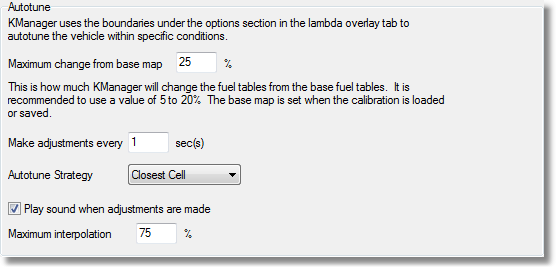Autotune is available for the KPro4 only
The autotune function is invoked by either the autotune button in the tool bar, or by the shortcut of ctrl-T. Tuning a vehicle using the autotune function uses the boundaries specified in the lambda overlay settings.
Note that fuel tables must have live tuning enabled for autotune to function.
Autotune Conditions

The minimum and maximum lambda is the boundary in which the function will perform tuning on the fuel tables. This boundary is necessary to prevent the function from making changes when the injectors cut off, or other events which cause the lambda values to oscillate.
Autotune

Maximum change from base map - this value is the maximum allowable percentage change from the base map. This value is to prevent the map from changing dramatically from your base map. The base map is set every time the calibration is saved or loaded.
Make adjustments every - this value is the time period the function must wait before making another change to the fuel maps. This delay is to help the lambda settle before reevaluating another change.
Autotune strategy - there are three adjustment strategies available for the autotune function.
| • | Closest cell, where the most heavily weighted cell is changed. |
| • | 4 weighted cells, where all four highlighted cells are changed based on the actual proportion of use. |
| • | Precise cell, where the most heavily weighted cell is changed only if the load and rpm is within 15% of the cell indexes. |
Play sounds when adjustments are made - this option is to play a high pitched sound when a fuel value is increased and low pitch sound when a fuel value is decreased.
Maximum interpolation - specifies the maximum distance between table cells where a lambda or sensor overlay value will be used. eg if cells are at 3000 and 4000 rpm and the engine speed is 3850 rpm, then the datalogged lambda value will be applied to both the 3000 and 4000 rpm cells, using a weighting based on the distance from each cell. For this example the 3000 rpm cell lambda value has less weight than the 4000 rpm cell lambda value. If the maximum interpolation is set to 80%, then the cells will only be updated if the engine speed is without 80% of the distance between the cells. For the example, the 3000 rpm cell will not be updated because 3850 rpm is more than 80% of the distance between 3000 and 4000 rpm, while the 4000 rpm cell will. This has the effect of filtering out overlay values which are too far from the actual engine speed and load. In practice this interpolation is weighted over two dimensions, so the maximum interpolation value applies to each dimension. This interpolation value is also used by the autotune function, except in the autotune function this value is used to calculate what percentage of the change to actually apply. For example, if a fuel cell value stands to be increased by 10% and the maximum interpolation value is 80%, then the fuel cell value will be increased by 8%.